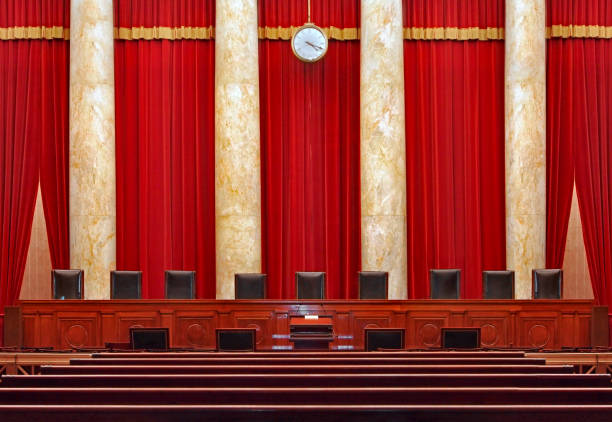The Supreme Court's process begins with a written petition to give judgment on a case. Cases come to the Supreme Court in the thousands. Nine Court Justices consider the case, from any kind of background. The Supreme Court serves as a model for other grand courts worldwide, but it exists as the strongest judicial power. "Their legitimacy is in the constitution, but their power relies on public faith in their independence and impartiality." It is their job to interpret the Constitution and uphold the rule of law based on their findings.
When a new justice arrives, the Court's nine justices convene for a group photo. There have been just over one hundred Supreme Court justices in the U.S.'s history, serving an average of sixteen years. Being elected to the Supreme Court is a rare opportunity. They often convene to help determine the government's power, whether it be ruling it legal or not, in particular, controversial cases.
When the government moved to Washington D.C. in 1801, John Marshall was elected Chief Justice. He is credited with giving the Supreme Court the ability to determine an act of Congress as unconstitutional. Under Marshal's leadership, the Court gained respect and was an effective tool in building the nation serving its place as a coequal branch of the government.
After twenty years, a slave from Missouri, Dred Scott, attempted to claim his freedom by citing the Constitution, and the Supreme Court ruled that Congress had no power to ban slavery and slaves could never be citizens, which would lose much of that respect Marshal had worked hard to achieve. The Civil War helped resolve the issue of slavery, and the Dred Scott case is the Court's biggest self-inflicted wound. The Fourteenth Amendment would give all American citizens the right to due process of law and equal protection.
In the modern day, the justices have two hundred years of history to reference and learn from to rule cases fairly. The Constitution we have today has survived through history and has been changed to embrace all American citizens, but it was not set to do that initially. The Court accepts about one hundred cases a year, and these cases are sent to justices every week. The Supreme Court looks to the other courts to determine if they've ruled properly based on Constitutional interpretations. Every week justices will convene to decide what cases they weigh in on. The Supreme Court has the right to not take cases, and determine if a case wasn't cared for properly.
When they debate what cases to choose, the Chief Justice first caps over the issues in the case and everyone contributes. The Court actively tries to improve itself, like how in recent years they've adopted a policy of letting everyone speak once before anyone speaks again. There has been a misconception that the Supreme Court can withhold information, but the entire branch is built on how there is no inside story. Everything is public information. "They (justices) have to wait for people to bring their problems to the Court." Unlike a senator or the President, the Supreme Court can't interpret the Constitution because they can, they have to have a case which causes them to interpret.
The Supreme Court hears cases in public. Lawyers have thirty minutes to make their argument before the court, and the nine justices listen to that oral argument. The oral argument helps answer questions the briefs don't answer. Lawyers when presenting their argument need to remember they have a captive audience of justices for a half-hour and must not waste that vital time. The lawyer must be reactive, not sticking to a prepared script of how they want things to go. It is a different experience for professionals of law to be on the Supreme Court because they are presenting an argument to nine judges instead of one or two. A great luxury the Court has today is picking out the national concern a case has and finding a resolution to it. After a few days, the justices will convene alone and come to a conclusion about the case.
After they've voted to decide the case, an individual justice on the majority side will write an opinion giving the legal reasons for the decision. Writing the opinion is the most time-consuming part of the justice's job because it's critical to helping other courts interpret the law correctly. Law clerks help with this process and the things that follow. The first draft takes about a month to develop. These drafts are sent to all nine justices to persuade the others to join that majority.
As the justices announce their decision in the courtroom, other judicial staff push out the opinion to the press. Within hours or minutes, the public will discover what the Supreme Court had done regarding the case and its rulings. If the Supreme Court ever stopped defending the Constitution or if the people stopped listening to the Supreme Court, America would cease to be the freest nation in the world. "The power of the Court is the power of the trust earned...".
A fun fact is that every time the justices meet they've adopted a tradition of shaking each justice's hands. I didn't know about that before, but I like how that encourages respect for each other. My biggest takeaway is that the Supreme Court has no power if it loses the trust of the people, which I think is good for accountability. The most surprising thing I learned was that the Supreme Court only accepts about one hundred cases a year. I thought it would be more, but in hindsight, that seems fair, especially with how long it takes to properly address a case. The video helped me gain a perspective that the Supreme Court is not for the government's benefit, but for the benefit of the people to hold the government responsible.


No comments:
Post a Comment